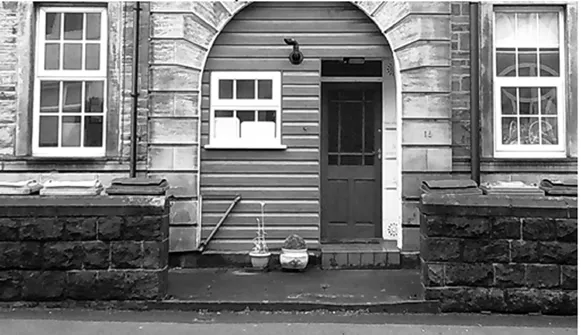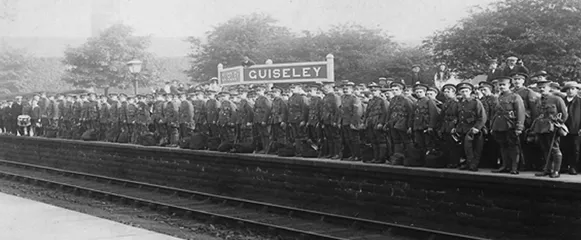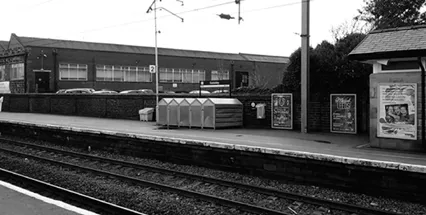
eBook - ePub
Guiseley Terriers: A Small Part in the Great War
A History of the 1/6th Battalion, Duke of Wellington's (West Riding) Regiment
- 272 pages
- English
- ePUB (mobile friendly)
- Available on iOS & Android
eBook - ePub
Guiseley Terriers: A Small Part in the Great War
A History of the 1/6th Battalion, Duke of Wellington's (West Riding) Regiment
About this book
After the Battle of the Lys in April 1918, Field-Marshal Sir Douglas Haig said of the 147th (Territorial) Brigade:'I desire to express my appreciation of the very valuable and gallant services performed by troops of the 49th (West Riding) Division since the entry of the 147th Brigade into the Battle of Armentires. The courage and determination showed by this division has played no small part in checking the enemys advance and I wish to convey to General Cameron and all the officers and men under his command my thanks for all they have done.'In April 1918, the Saturday night soldiers from Bingley, Guiseley, Haworth, Keighley, Settle and Skipton halted the German advance at a critical time in the war during the German spring offensive. Haigs Backs to the Wall order had just been issued when the 1/6th Duke of Wellingtons Regiment was sent to the front-line at Armentires. After nearly four years at the front, they had been transformed from part-time enthusiastic amateurs to battle hardened veterans, having fought in some of the Great War's major battles, including suffering the effects of mustard gas at Nieuport. It was a source of pride to the men of the battalion that they had never given up ground to the enemy, unless ordered to by a higher authority, and only then reluctantly.Using newspaper archives, war diary extracts, personal accounts and previously unpublished photographs, Stephen Barber retraces the formation and history of the 1/6th Duke of Wellingtons Regiment from the creation of the Volunteer Rifle Corps in 1860, to its mobilisation in the Great War. A day-by-day account of their movements and actions over the four-year period culminates in the pursuit of the retreating German Army at Famars, on 1 November 1918.
Frequently asked questions
Yes, you can cancel anytime from the Subscription tab in your account settings on the Perlego website. Your subscription will stay active until the end of your current billing period. Learn how to cancel your subscription.
At the moment all of our mobile-responsive ePub books are available to download via the app. Most of our PDFs are also available to download and we're working on making the final remaining ones downloadable now. Learn more here.
Perlego offers two plans: Essential and Complete
- Essential is ideal for learners and professionals who enjoy exploring a wide range of subjects. Access the Essential Library with 800,000+ trusted titles and best-sellers across business, personal growth, and the humanities. Includes unlimited reading time and Standard Read Aloud voice.
- Complete: Perfect for advanced learners and researchers needing full, unrestricted access. Unlock 1.4M+ books across hundreds of subjects, including academic and specialized titles. The Complete Plan also includes advanced features like Premium Read Aloud and Research Assistant.
We are an online textbook subscription service, where you can get access to an entire online library for less than the price of a single book per month. With over 1 million books across 1000+ topics, we’ve got you covered! Learn more here.
Look out for the read-aloud symbol on your next book to see if you can listen to it. The read-aloud tool reads text aloud for you, highlighting the text as it is being read. You can pause it, speed it up and slow it down. Learn more here.
Yes! You can use the Perlego app on both iOS or Android devices to read anytime, anywhere — even offline. Perfect for commutes or when you’re on the go.
Please note we cannot support devices running on iOS 13 and Android 7 or earlier. Learn more about using the app.
Please note we cannot support devices running on iOS 13 and Android 7 or earlier. Learn more about using the app.
Yes, you can access Guiseley Terriers: A Small Part in the Great War by Stephen Barber in PDF and/or ePUB format, as well as other popular books in History & Military & Maritime History. We have over one million books available in our catalogue for you to explore.
Information
Chapter 1
Embodiment and Deployment
The 6th Duke of Wellington’s (West Riding) Regiment (DWR) was formed on 1 April 1908 as part of the Haldane reforms of the British Army. Richard Haldane was the Secretary of State for War from December 1905 to June 1912, and proposed that militias, yeomanry units (men who had access to a horse) and volunteer forces (VF), whose primary role was home defence in a state of emergency, would be combined to create the Territorial Force (TF). Prior to 1908, the Guiseley unit was known as K Company of the 3rd (Volunteer Battalion), The Duke of Wellington’s (West Riding) Regiment. The now demolished drill hall used by this unit was located on Springfield Place, Guiseley. This building was used by the Guiseley Territorial Force until 1912 when a new drill hall was built on Victoria Road.
The new TF units of 1908 became a numbered battalion of the local regular army regiment. As well as weekly training sessions, they attended an annual summer training and weekend camps. They were part-time soldiers like the modern Army Reserve and received regular army pay for their time. The men were legally bound to attend the training camps and could find themselves in front of the local magistrate if they defaulted without a good reason.
Their terms of service did not require the men to serve overseas, but they could volunteer as, virtually to a man, they did in 1914. A number of TF men, for whatever reason, did not volunteer and others were required to remain in the United Kingdom, for home service.
On 15 August 1914 orders were issued to separate the home service men from those who had undertaken to serve overseas. This was with the intention of forming reserves made up of the home service men. On 31 August 1914 authority was given to establish a second line division for each of the first line units where more than sixty per cent of the men had volunteered. These divisions were formed from late 1914 onwards, although the permissible strength of a second line unit was initially only half of the normal establishment. This was raised to full establishment early in 1915, after which many of the men were sent overseas, with some playing important parts in the fighting.
When the Military Service Act (conscription) was introduced in 1916, all men were deemed to have agreed to overseas service and thus all second line units became available to be sent abroad. It was at this time that the foreign service battalion was given the prefix number 1 to become the 1/6th DWR, and the home service battalion became known as the 2/6th DWR. Later in the war, the 2/6th DWR was mobilised for foreign service and a home service training battalion was created which became the 3/6th DWR. The men volunteering for overseas service were entitled to wear the Imperial Service Badge above the right breast tunic pocket. The badge, which was made of cupro-nickel, was declared obsolete in October 1920 when the Territorial Force was renamed the Territorial Army.

Imperial service badge.
The 1/6th DWR were part of the West Riding Division, later titled 49th (West Riding) Division. The home service battalion was titled 2/6th DWR and became part of the 2nd West Riding Division, later titled 62nd (2nd West Riding) Division. Many men from Bingley, Haworth, Guiseley, Keighley, Settle, Skipton and the other towns from which the 6th DWR recruited, served in the 2/6th DWR which suffered heavy losses on 3 May 1917 during the attack on the Hindenburg Line at Bullecourt in France.
In August 1914 the West Riding (Territorial) Division (later renamed 49th Division) comprised the following units:
1st West Riding Infantry Brigade (later renamed 146 Brigade) – 1/5th, 1/6th, 1/7th and 1/8th Battalions of the West Yorkshire Regiment.
2nd West Riding Infantry Brigade (later renamed 147 Brigade) – 1/4th, 1/5th, 1/6th and 1/7th Battalions of the Duke of Wellington’s (West Riding) Regiment.
3rd West Riding Infantry Brigade (later renamed 148 Brigade) – 1/4th and 1/5th Battalions of the King’s Own Yorkshire Light Infantry and the 1/4th and 1/5th Battalions of the York and Lancaster Regiment.
Within 147 Brigade the 1/4th DWR had drill halls in Halifax, Brighouse, Cleckheaton, Elland and Sowerby Bridge.
The 1/5th DWR originated from the Huddersfield area and the 1/7th DWR were based around the Milnsbridge area.
The division was commanded by Major General T.S. Baldock CB and Brigadier General E.F. Brereton DSO commanded the 2nd West Riding Infantry Brigade.
On 26 July 1914 the men of the 2nd West Riding Infantry Brigade attended a two-week summer training camp at Marske, located between Redcar and Saltburn in North Yorkshire. This was the annual training for the brigade units which included the 1/6th DWR comprising seven companies from the following towns: A and B – Skipton, C – Guiseley, D and E – Keighley, F – Settle, G – Haworth and H – Bingley.

Shoulder badge of the 49th (West Riding Division)
Even before the men departed for the camp, tensions had been running high in Europe since the 28 June assassination of Archduke Franz Ferdinand, heir presumptive of the Austro-Hungarian Empire, in Sarajevo, Serbia. A complex series of treaties and alliances existed between Serbia, Russia and France as well as Germany and Austria-Hungary. On 28 July Austria-Hungary declared war on Serbia and on 29 July, there was a general mobilisation of the Russian army which produced an ultimatum from Germany for the Russians to stand down. The following day the mobilisation of the German and French armies was ordered by their respective governments but the Germans had secretly been concentrating troops on the French/Belgian border for several days. On 1 August, Germany declared war on Russia and secretly signed an alliance treaty with the Ottoman Empire. The next day, 2 August, the German army crossed the border into Luxembourg without a declaration of war. On Monday 3 August Germany declared war on France and the Belgian government refused permission for German forces to pass through its territory. On the same day, the ‘terriers’ camp was broken up and the companies returned to their local drill halls.
On Tuesday 4 August the government of the United Kingdom sent an ultimatum to Germany not to invade Belgium. On the same day, German troops crossed the Belgian border to attack the city of Liège and, just before midnight on 4 August 1914, the Government of the United Kingdom declared war on Germany. The various companies of the 6th DWR received their embodiment orders and the men from Guiseley mustered and marched from the drill hall on Victoria Road to Guiseley station where they boarded a train and travelled to Skipton to join the rest of the battalion.

1914 – Posing outside the Drill Hall on Victoria Road, Guiseley are a group of men about to be trained for service abroad. Lieutenant Malcolm C.M. Law (in uniform) seated in the centre. (Aireborough Historical Society)
On the evening of Tuesday, 4 August 1914, Captain Chaffer and Lieutenant Law departed from Guiseley station with sixty-two men. Crowds assembled from the drill hall on Victoria Road to the station to cheer them on their way. The Wharfedale and Airedale Observer reported:

The Drill Hall, 101years later, now converted into flats.

Embodiment – C Company on Platform 1, Guiseley Train Station, August 1914. (Aireborough Historical Society)

Same location in 2016.
Long before the hour of the march to the railway station crowds began to gather in Victoria Road, at the tram terminus and along Station Road and by nine o’clock these thoroughfares were packed by a seething mass of the inhabitants, anxious and desirous of giving the Territorials an enthusiastic send-off.
Canon Francis Howson, Rector of St Oswald’s Church in Guiseley placed a roll of honour in the church porch and the church bell was rung for two minutes each day at 12.45pm to remind the inhabitants of the town to pray for the men. Mr Hollingsworth, headmaster of St Oswald’s school on The Green, assembled photographs of former pupils to create a patriotic gallery of those who were serving their country.
The 1/6th DWR became part of 147 (West Riding) Brigade of the 49th Division and on 5 August the battalion moved to the small village of Healing in Lincolnshire, between Immingham and Grimsby, to commence training and coastal defence. After about a month they moved 4 miles inland to the village of Riby where they were billeted in a tented camp. Riby was a brigade camp so also present were the other units that formed the brigade, namely the 1/4th, 1/5th and 1/7th Battalions of the DWR, as well as a battery of artillery from the 4th (West Riding) Howitzer Brigade, Royal Field Artillery. The 10th (Otley) Battery had their HQ at the drill hall in Nelson Street, Otley, opposite the bus station where the Post Office now stand...
Table of contents
- Cover
- Title Page
- Copyright Page
- Contents
- Foreword
- Maps
- Origins
- Chapter 1. Embodiment and Deployment
- Chapter 2. Deployment to the Western Front – Fleurbaix
- Chapter 3. Ypres
- Chapter 4. The Gas Attack
- Chapter 5. Thiepval
- Chapter 6. Battle of the Somme
- Chapter 7. Gommecourt
- Chapter 8. Berles-au-Bois
- Chapter 9. Wailly
- Chapter 10. Neuve Chapelle
- Chapter 11. Hulluch
- Chapter 12. Nieuport
- Chapter 13. The Third Battle of Ypres (Battle of Passchendaele)
- Chapter 14. The German Spring Offensive of 1918
- Chapter 15. The Battle of the Lys
- Chapter 16. Return to Ypres
- Chapter 17. Naves and Famars
- Chapter 18. Armistice and Demobilisation
- Bibliography